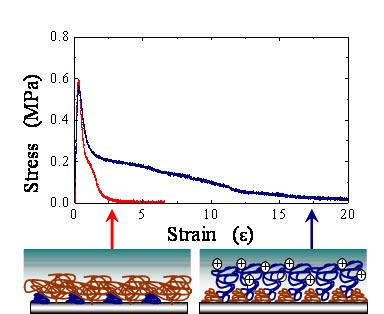 The interfacial debonding of very deformable materials such as soft adhesives depends of course on the mechanical properties of the adhesive itself but depends also on the chemical composition and surface roughness of the adherent which provides a boundary condition to the deformation of the material imposed by the applied load.
The interfacial debonding of very deformable materials such as soft adhesives depends of course on the mechanical properties of the adhesive itself but depends also on the chemical composition and surface roughness of the adherent which provides a boundary condition to the deformation of the material imposed by the applied load.
The surface of the adherent can be modified either chemically (by modifying the surface with functional groups or with polymers capable of entanglements with the adhesive material, or topographically through a modification of the surface roughness.
In both cases the debonding mechanism will be modified and a relatively complex coupling between the deformation properties of the adhesive and the interactions at the interface will determine the observed debonding pattern.
More info
H. Retsos, A. Kiriy, V. Senkovskyy, M. Stamm, M. M. Feldstein and C. Creton (2006) "Controlling tack with Bicomponent Polymer Brushes", Adv. Mat. 18 (19), 2624-2628.
Josse, G., Sergot, P., Dorget, M. and Creton, C. (2004). "Measuring interfacial adhesion between a soft viscoelastic layer and a rigid surface using a probe method." Journal of Adhesion, 80 (1-2), 87-118.
Chiche, A., P.Pareige and C. Creton (2000) "Role of surface roughess in controlling the adhesion of a soft adhesive on a hard surface" Comptes Rendus de L’Académie des Sciences, Série IV, 1 : 1197-1204.
C. Creton, G. Josse, A. Chiche. "Mécanismes d ’adhésion et contrôle de l ’adhérence pour les matériaux très déformables" Proceedings of the 9èmes journées de la formulation, Lyon, France, 9-10 december 2002.



